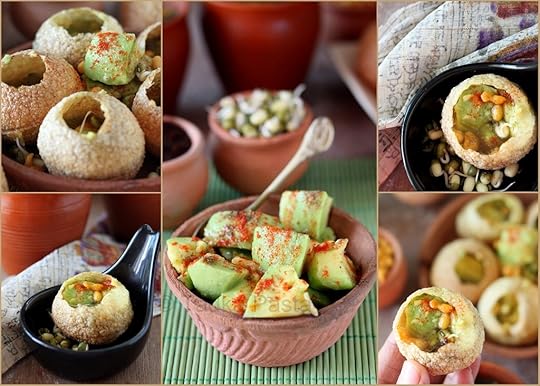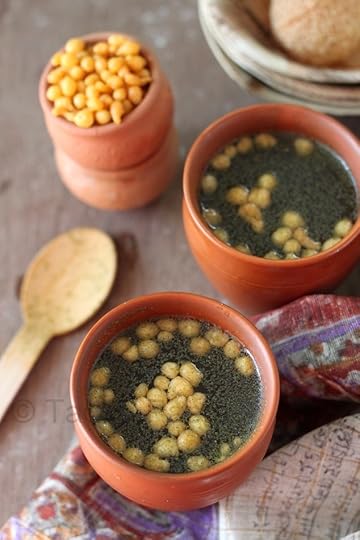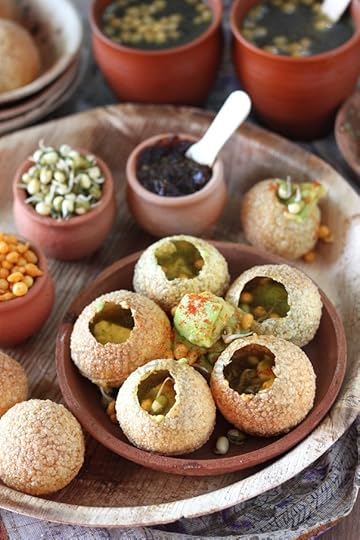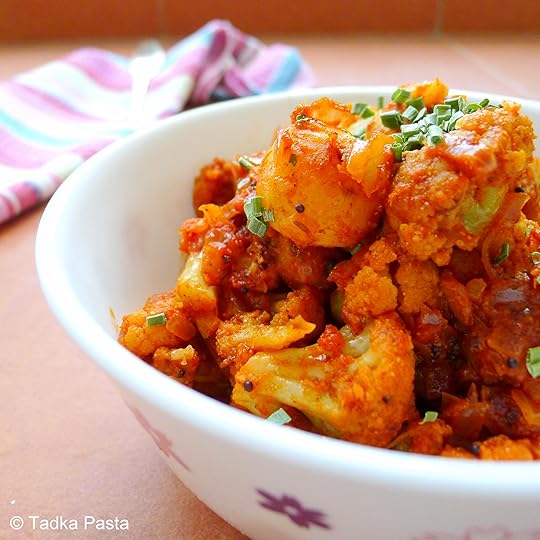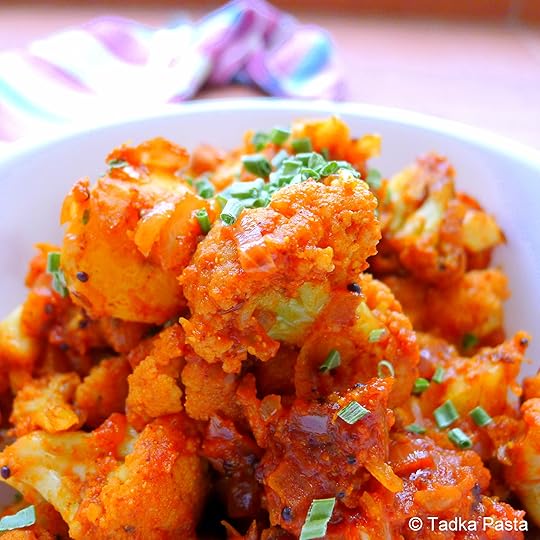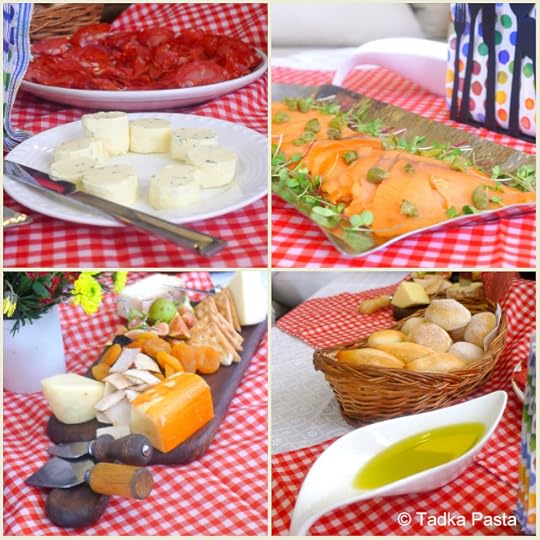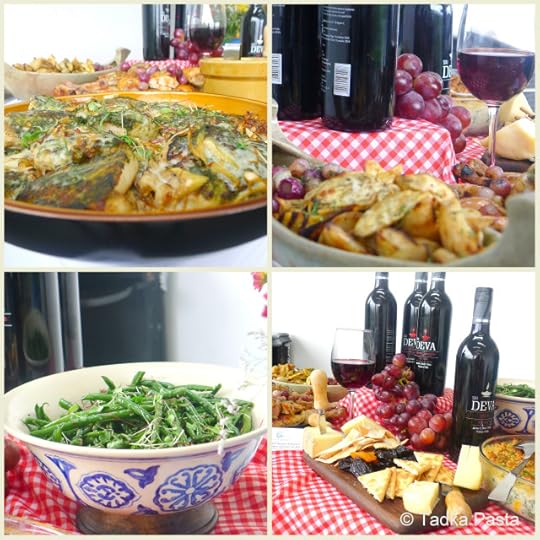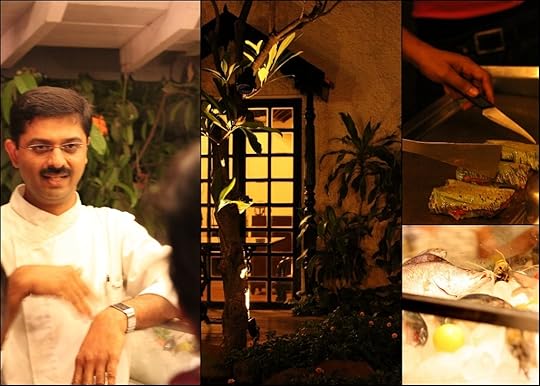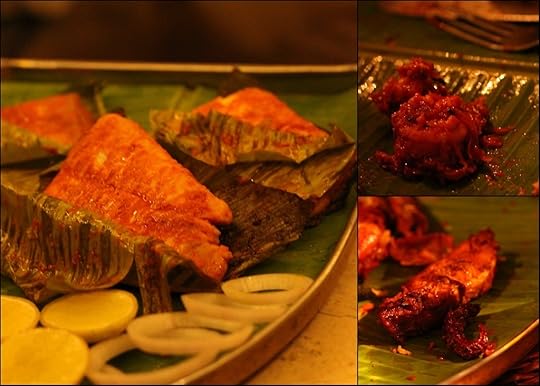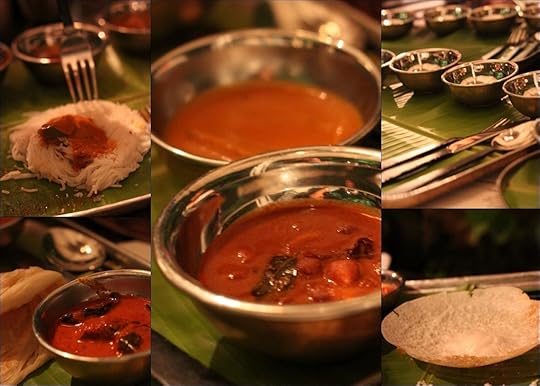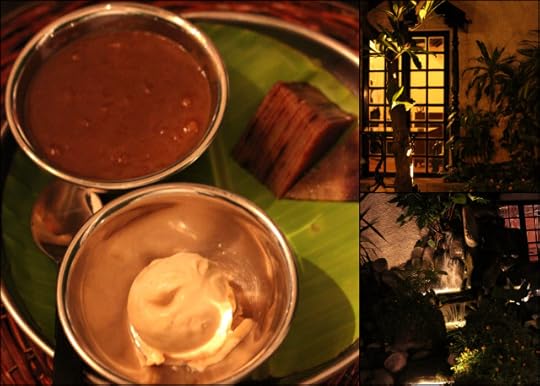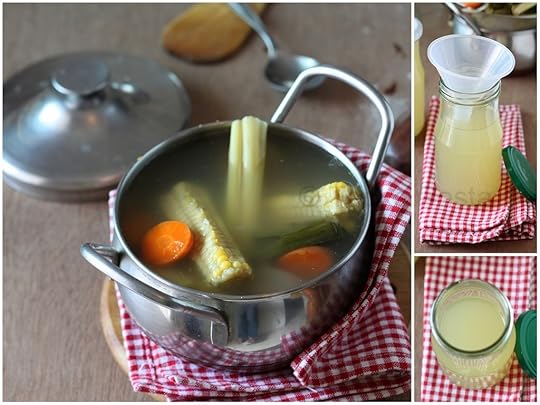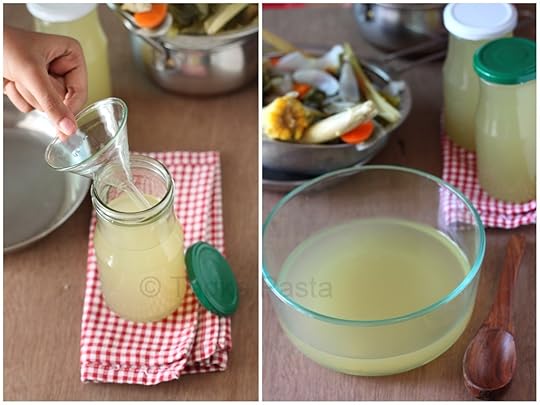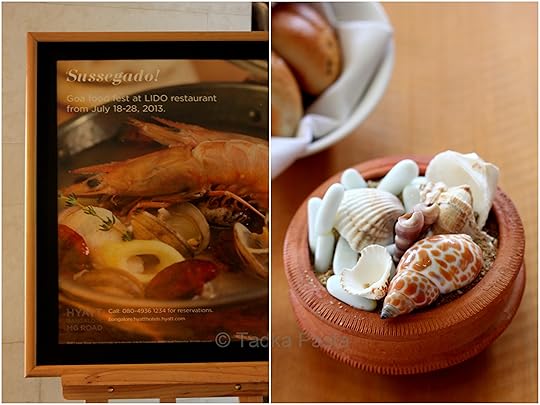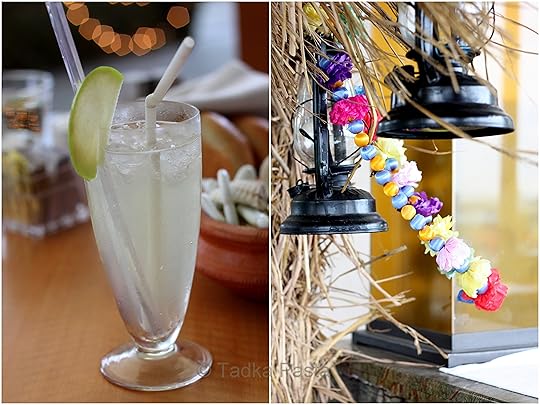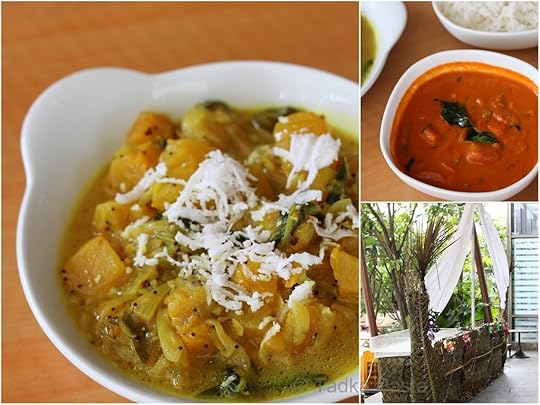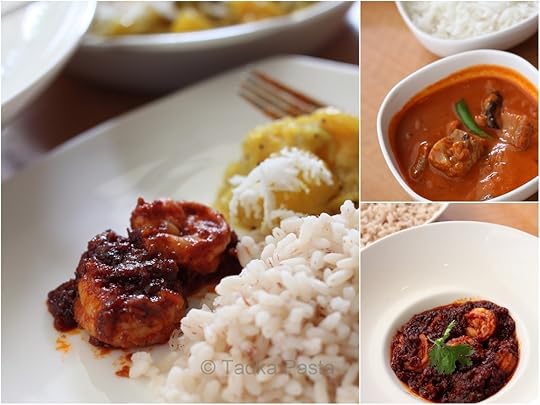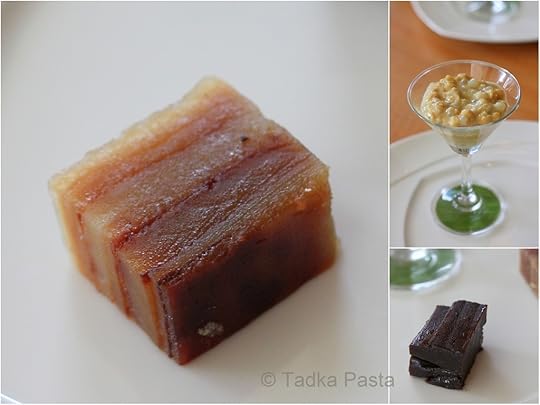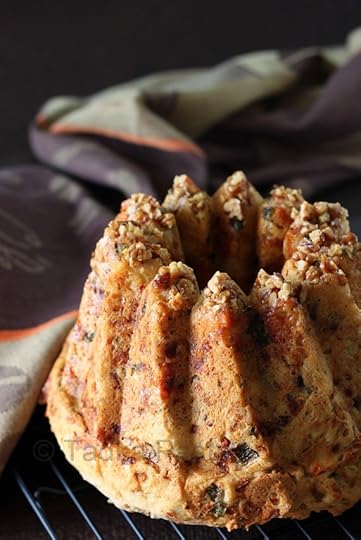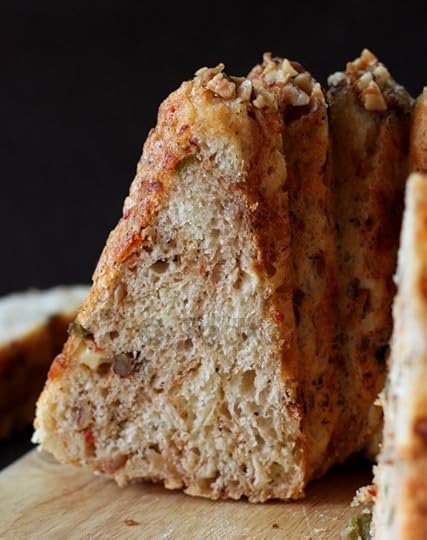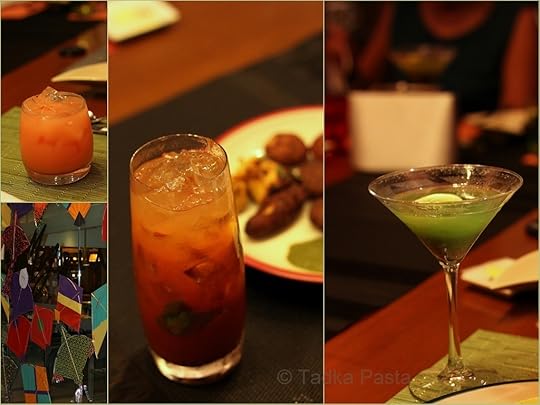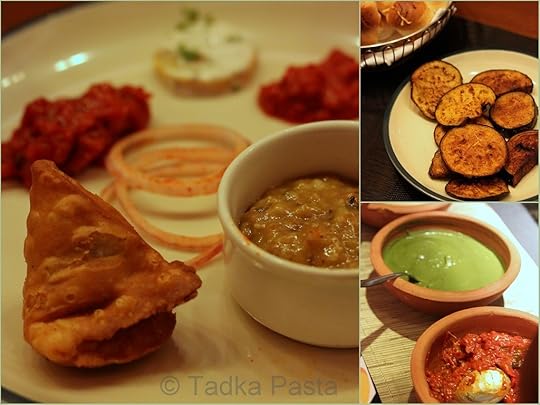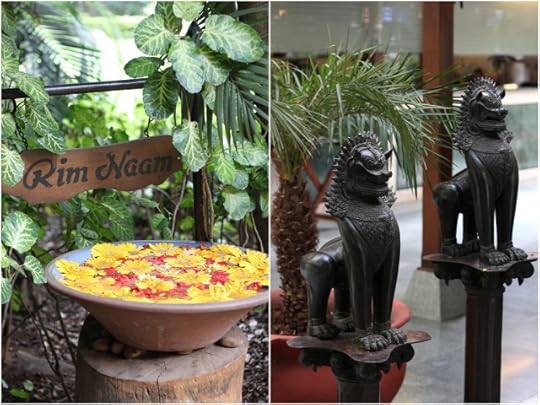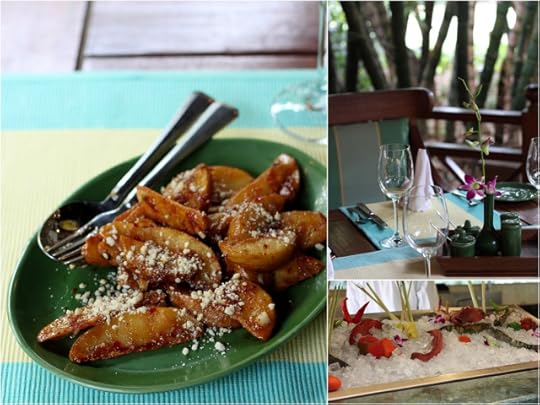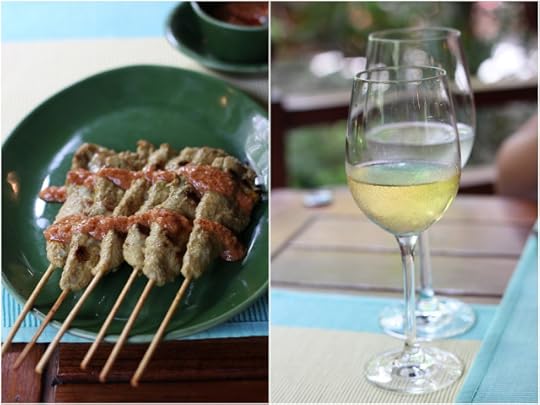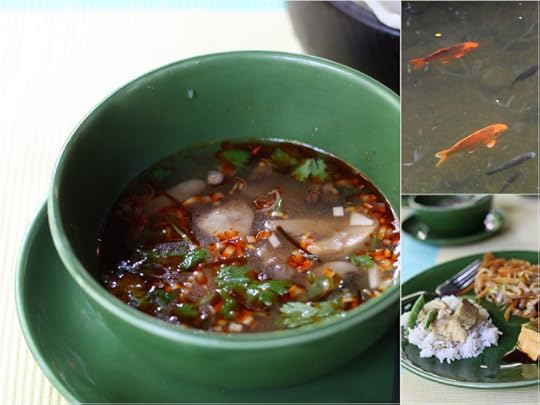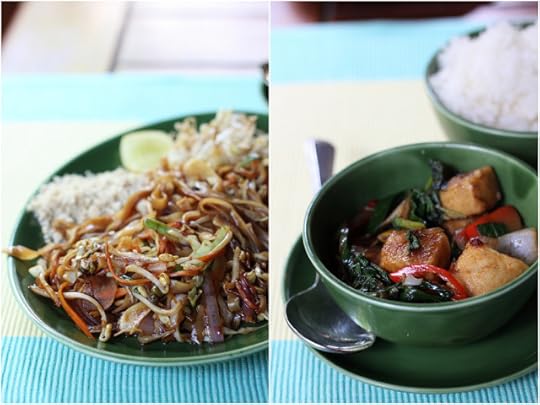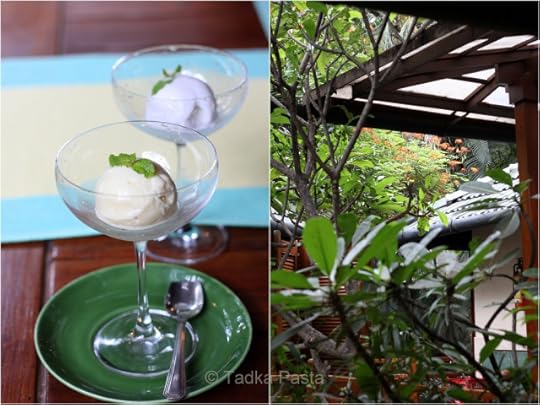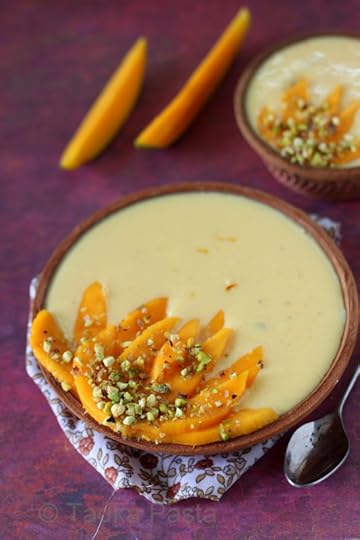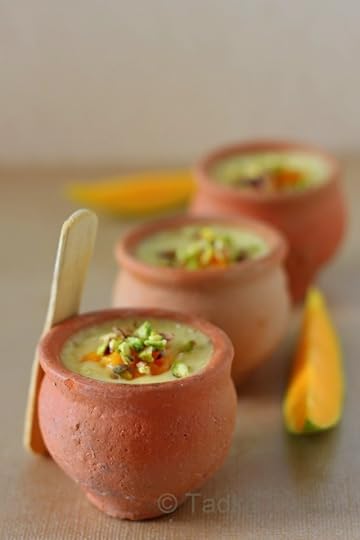Ranjini Rao's Blog, page 11
September 3, 2013
Gulp And Gone! Avocado Pani Puri.
The buttery, creamy, melt-in-your-mouth texture of avocados is far too appetizing to let go of a chance to use them in our recipes. When we’re left with a heap of avocados, when we’ve made ample batches of sandwiches and kababs in the days leading up to the acquisition of a fresh lot, we don’t blink twice before jazzing it up to use in another fun-filled snack, pun unintended. These roly-poly deep-fried beauties come alive with the punch of sweet-hot-sour tastes of the typical chaat variety, and the lusciousness of avocados walloped with a dusting of chilli powder and a squirt of lemon juice.
Avocado Pani Puri
(Serves 3-4)
1 Avocado
1 Lemon
30 Puris
¼ Cup fresh mung dal sprouts
Salt and chilli powder, chaat masala to taste
¼ Cup sweet tamarind chutney
Pani or spiced water (recipe follows)
Slit the avocado into 2 halves and remove the seeds. Scoop out the flesh using a sharp-edged spoon and cut it into chunks. Transfer the chunks to a bowl and squeeze some lemon juice all over the chunks. Sprinkle with salt, chilli powder and chaat masala to taste.
When you are ready to serve, crack the tops of the puris and make a hole just enough to fill them. In each puri add an avocado chunk, some mung sprouts and a dollop of sweet chutney as the filling. Pass the Pani in wide-mouthed cups, one for each person. Dip the filled puris in the Pani and stuff the entire puri in your mouth.
Tadka’s Shortcut Pani for Pani-Puri
1 Litre cold water
¼ Cup mint-coriander chutney (Or 2 cups mint+1 cup coriander leaves+2 green chillies ground to a paste)
2 Tablespoons sweet tamarind chutney
½ Teaspoon chaat masala
½ Teaspoon kala namak or powdered rock salt
2 Tablespoons boondi
Stir the chutneys and spices into the water. Top with the boondi just before serving.
Note:
For a dressed up version of the avocado filling, mix in some finely chopped onion, tomato, minced green chilies and cilantro/ coriander leaves before squirting the lemon juice.


August 21, 2013
The Everyday Side Dish – A Pickle No More
From raging reds to flaming yellows, Springy greens to pristine whites, the colors of Indian food are as much a feast to the hungry eyes as they are to the discerning nose and desirous taste buds. Red hot chilies and turmeric, fiery green chilies and fresh coconut, all these ingredients, in distinct combinations and permutations, or as stand alone bases for gravies and sauces, lend their striking and mellow flavors all the same to the entirety of a recipe, enhancing the tastes of vegetables and meats and making them much favored and sought after. While there could be scores of uses for each of them, we went with the Pickling Spice/ Achaari flavors to wallop the mundaneness out of the time-tested everyday side dish: Aloo Gobhi. The slightly tangy, mostly spicy masala makes this recipe a hit, even with the undertone of the mildly bitter methi/ fenugreek, which, to be sure, is actually what rounds this dish off.
Achari Aloo Gobhi/ Baby Potatoes And Cauliflower In Pickling Spices
(Serves 3-4)
2 Tablespoons + 1 tablespoon sesame/ til oil
1 Teaspoon each: mustard and cumin seeds
1/2 Teaspoon turmeric powder
1 Large onion, finely chopped
1 1/2 Teaspoons garlic paste
1 Medium-sized cauliflower, cut into florets and soaked in warm water with a bit of salt, for 5 minutes.
10-12 Baby potatoes, peeled (and microwaved with a sprinkling of water for 1-2 minutes, 30 seconds at a time)
3 Tablespoons tomato paste
Salt to taste
1 Teaspoon red chilli powder
2 Tablespoons pickling spice powder (see below)
1/2 Teaspoon garam masala
1 Teaspoon brown sugar
2 Teaspoons vinegar
2-3 Tablespoons water
1 Tablespoon finely chopped green onions or chives for garnish
Warm the 2 tablespoons oil in a pan/ kadhai, and add the mustard and cumin, followed by the turmeric, once they crackle. Add the onion, fry for a minute or so, then add the garlic paste. Drain, pat-dry and toss in the cauliflower florets and fry for 4-5 minutes on a low-medium flame. Then add the potatoes, tomato paste, salt, stirring well to mix everything in. Add the masala powders and mix well so they coat the vegetables thoroughly. Add the brown sugar, vinegar, and the remaining 1 tablespoon oil, stir well, and finally add the water, cover and cook on a low flame for 8-10 minutes. Garnish with the green onions/ chives and serve hot with rotis.
Pickling Spice Powder
1 Tablespoon mustard seeds
1 Tablespoon lightly roasted fenugreek/ methi seeds
1-2 Red Chillies (optional)
Grind the above to a fine powder in your coffee grinder or small blender container. This recipe can be doubled or tripled and the excess stored in an airtight container for upto 2 weeks.


August 13, 2013
Wine Tasting At SDU Winery
When you’ve traversed enough wine trails and had your share of exquisite Rieslings and Sauvignon Blancs from the Brancotts down in Kiwiland, and Old Barrel Ports and Cabernet Francs from family-owned wineries in Midwestern United States, you’re considered, well, a weathered wine buff. Atleast a little more than you’d be if all your winely knowledge trickled down from say, Paul Giamatti in Sideways. But we digress.
A quaint little winery beckoned a bunch of food bloggers for an exclusive tasting event recently. Nestled in the lush hillsides of Nandi, just outside Bangalore, SDU is a boutique winery with vineyards (currently not in bloom) within an arm’s length from its manufacturing unit. The drive, which lasted about 2 hours, was pleasant, offered some countryside vistas to the sore suburban eyes, and was peppered with invigorating conversations about everything under the sun except food, wine or blogdom. Seen above is the vineyard, from a distance, on a pit stop along the way.
Upon reaching the vast expanse that houses the SDU unit, we were ushered in by the kindly Mr. Mohit Nishchol, Business Head at SDU, who inadvertently opened up a discussion about the winery and answered some (even unbecoming of said wine connoisseurs) questions. The most relevant of those, however, was that SDU is really aiming to create a healthy awareness about easy drinking wines among the general public. That being said, their doors are not really open to the public, and they retail their wines through select outlets. We would also learn a few moments hence that you can’t really walk out of SDU with a wine bottle tucked into your pocket – because they are not licensed to sell wines right out of the unit – and hence the CCTV cameras would nicely capture your little act.
After we’d sipped on our teas and coffees and wolfed down a few platters of snacks, we visited the machinery unit, with the gigantic tanks where the red and white wines are fermented and kept until they’re ready to be bottled, a well planned assembly unit that functions on stringent rules and rigmaroles, ridding the bottles of all oxygen content before they’re sealed, labeled and sent out to the other relatively colder room where they’re packed into cartons. Of course we also went to a precision lab where everything, from brewing temperature, to carbonic maceration, is monitored with hawk-eyed perfection. It also reminded us of colleges or hospitals (or both), with whiffs of ether and phenyl wafting across the span of the chamber. Next stop was the room with the French Oak barrels, where the reserve wines were, well, resting.
The wine tasting event that followed shortly after, was rolled out in front of us like a cheery picnic mat, quite literally. Oodles of cheeses and olives, nuts and breads, crackers and chorizo, ham and smoked salmon, were spread out on a gigantic table swathed in a red-and-white checkered table cover, around which we were seated in anticipation of the fruity, oak-kissed, acidic liquids to hit our mouths. The 4-S rule was reasserted just in time – see, smell, sip, swirl – while some of us had already dug into the snack accompaniments. After much ado about the wine tasting process, we finally sampled the 2012 vintage numbers: Deva Cab Suav and the Deva Syrah, as well as the soon to be launched Deva Chardonnay. While the Syrah is a a light wine with a not-too-overwhelming peck of spice-like flavors in the background, the Cab Sauv is a full-bodied wine with a rather immodest hint of fruitiness and spice-like flavors as well. The Chardonnay is a lovely white wine, dry and fruity with a lingering effect on the palate. We are quite sure there’ll be fireworks in the market when it’s launched later this year.
Still heady from all the tasting, we were given strict instructions to guzzle down a bottle of water before being taken out to the balcony for a scrumptious lunch, which was washed down with more wine. While the drive back home was just as enjoyable as the drive up to the winery, we couldn’t help take a second look at our prized possessions: two bottles of select Deva wines, and think ahead to the dinners they will likely rule over.
As all reviews must come to an end on a good note, here’s ours: the Cab Sauv is priced at Rs. 600/- a bottle and the Syrah, at Rs. 500/- a bottle. Quite the bargain for delicious, easy-on-the-palate wines from a lovely boutique winery.


August 10, 2013
Restaurant Review: Karavalli, Bengaluru
The scene – a balmy evening in Bengaluru, tables set around a cooking station, fresh seafood on a bed of crushed ice, bowls of fragrant marinades, a chef standing over a well-seasoned grill to bring it all together on banana leaf-lined platters. It was a showcase of new additions to the menu at Karavalli, aptly called – West Coast Seafood Grill and Wood Fired Dishes Experience.
Executive Chef Naren Thimmaiah kicked off the evening by informing the blogger invitees about the dishes added to the iconic menu from different regions on the Konkan coast, including vegetarian specialties from Mangalore and other areas. The chef’s love for coastal cuisine and his expertise in the field made his introduction really interesting and then we were onto the lovely seafood grilling experience. Diners can choose from Scampi, Red snapper, Black Pomfret, Indian Salmon etc., then pick their choice of marinade and have it cooked by a chef or opt to grill it themselves. A couple of guests chose to man the grills under chef’s supervision while the rest of us watched and tried to pick up some pointers on grilling seafood.
First to sizzle were the scampi in a fiery Goan masala. The huge scampi were coated in a reddish-orange marinade and then thrown onto the heat. After some time they were covered briefly with a vessel, in order to cook thoroughly without drying out the meat. As part of the plating, all the delicious browned bits were scraped up from the tava and used as a finger-licking garnish on the scampi!
The next feature was Meen Eleittad, delicate fillet of fish lavishly coated with a spicy marinade, enfolded in a banana leaf and grilled to perfection. The banana leaf envelope ensured that the fish came out fork-tender and juicy, with nary a hint of toughness on the skin. This is a technique we’re borrowing for sure.
Also served at the table were Chemeen Roast – lightly cooked prawns in a dark, onion-y masala and a lovely slice of fried fish coated sparingly in spices. All the preparations were full of flavour and definitely on the hotter side, so if you enjoy a higher scale of heat, you will love this menu.
The vegetarian starters included a raw-banana fry dish from Kerala – Pachakkai Varathathu that was absolutely delicious and addictive. The crescent-shaped slices of banana had been deep-fried and then tossed in a lovely blend of spices, with a hint of coconut perhaps.
The Kaju Kotambir Vadi, though described as ‘coriander-tossed masala cashews’ were more like coriander fritters with cashewnuts, nicely crisped-up and satisfying. The third appetizer was an offering of tiny rice dumplings in a powdery coconutty dressing with bits of crunchy urad dal, slightly reminiscent of our favourite snack of cocktail idlis brushed with ghee and a dry chutney.
All the curries in the main course had been cooked in wood-fired clay pots, we were told. Mounds of steaming idiyappam were served alongside, topped with shards of fresh grated coconut. The appams with their perfectly crispy sides and thick, spongy centres, and the Malabar-style paranthas were perfect to soak in and scoop up the gravies.
The chef told us that the home-style dish of brown chickpeas in a dark sauce – Kadala Gassi originated in South Canara. Our pick though was the Maavinakai Mensukkai, a preserved mango curry that was sweet, sour and spicy, rich with coconut milk and really tasty.
For the non-vegetarians there was Meen Vevichathu – succulent pieces of seer fish in an excellent curry, the chilli base was balanced well here with a nice tang from the tamarind. The Karavalli Mutton Curry looked thick and creamy, but at that point we were really full and could not do it real justice.
The trio of hot, cold and room temperature desserts had something for every kind of sweet tooth. Of course, we had to start with the Tamarind Ice cream that had just the right amount of tartness in the sweet cream base. Chef explained to us how they had experimented to get this edgy balance. The ever-popular Goan Bebinca tasted fresh, and the eggy layers had been flavoured with nutmeg, as is traditional. The Ada Pradhaman was divine and rich and got a nod from everyone at the table.
We really enjoyed the food and service at Karavalli and would recommend it to anyone who’d enjoy a sumptuous meal with authentic dishes, all hand-picked from India’s West coast and beautifully cooked in traditional styles.
Address: Karavalli @ The Gateway Hotel,
Residency Road
Bangalore
Availability: Lunch & Dinner
Cuisine – South Indian Coastal, with Seafood specialties
Phone: +91 80-66604545
Accepts Cards: Yes
Parking: Valet


July 29, 2013
Soup-erb Stock from Scraps
On a blustery, rainy evening, when the mind is set on a slow-simmered pot of soup, there can’t be too much to nitpick or niggle about if all the ingredients are within arm’s reach to whisk up something that only feels like it was slow-simmered, whereas it actually comes together in a trice. Which is why, on other blustery evenings, we put in a bit of work that will come in handy on a, well, rainy day.
A home-made, robust and flavorful stock from scraps of vegetables that we’re all too familiar with, when they’ve been used and left to lounge in the refrigerator trays until they’re sighted upon and deemed fit for the garbage. Stems and stalks, tops and ribs, and all manner of nutrient-rich in-betweens go into this hearty preparation, and it enhances the flavor quotient of soups, rice varieties, or even breads, should you use it to knead the dough.
Vegetable Stock from Kitchen Scraps
(Makes about 2 litres)
2½ Litres water
3 Corn cobs
2 Leek tops – the dark green parts
2 celery ribs with leaves, cut into 1″ pieces
Stem of one broccoli head, cut into thick slices
Handful of cilantro stems
Handful of spinach stems
1 large onion, cut into thick slices
1 large carrot, cut into thick slices
1 Lemongrass bottom, chopped, optional
1 knob galangal or ginger, smashed
Bring the water to a boil in a large stockpot.
Meanwhile prepare the corn cobs. Hold a cob vertically in a large platter and use a knife to cut off the kernels. Turn and repeat on all the sides. Do the same with the remaining cobs. Reserve the kernels for another use.
Put the corn cobs and the other ingredients except the lemongrass and ginger into the boiling water. Cover and simmer for 30 minutes.
Add the lemongrass (if using) and ginger to the stock pot. Simmer for 10 minutes.
Remove the pot from heat and strain the stock. Discard the vegetables.
Allow the stock to cool completely and then store in glass bottles or containers. Refrigerate and use over the next week. You can also freeze the stock to use later.
You can use this stock in all kinds of soups and stews instead of water to add an extra depth of flavour. Add salt and seasonings based on the soup recipe. Use galangal and lemongrass if you’d like to give the stock a hint of Thai freshness or leave them out for regular stock.


July 25, 2013
Restaurant Review: Goa Food Festival at Lido
The damp and drizzly Bangalore weather this time of the year calls for a shot of heat and spice to enliven things up and the Sussegado! Goa food festival at the Lido restaurant at Hyatt, Bangalore promises to do just that. Chef Edrige Vaz who is visiting from Park Hyatt, Goa has put together a seafood-centred Goan spread for a buffet every night until 28th July 2013. There is also a pared-down a la carte menu available at lunch, which is what we opted for. The chef took the onus of selecting the dishes for us and served us a lovely three-course-meal amidst billowing palm trees and some beach-style decor.
The menu had quite a few interesting options for Goan-themed cocktails and mocktails, of which we tried a green-apple flavoured coconut water drink that had just a hint of peach nectar. As promised, it was light and refreshing and not too sweet. Meanwhile, the long wait for the food to arrive had us eyeing the bread rolls at the table but we held on and were thus able to attack the appetizers with gusto.
The vegetarian appetizers, though beautifully plated were a bit disappointing – a cutlet and a croquette were served that didn’t really have us hankering for seconds. The Stuffed Mushrooms smothered in a peri peri masala, on the other hand, were succulent and perfectly cooked. They were a real treat and we were happy to have them repeated on the non-vegetarian snack platter too.
The non vegetarian appetizers fared far better. The Rawa Fried fish fillet was truly dynamite - the fish used was bhekti – the sort that you would find being fried up at tiny seaside shacks. The Chicken Cafreal, wrapped in a green masala of coriander and chillies and served on a skewer was deliciously tender and delightfully spiced as well.
The main course was served family style, along with bowls of white and brown Goan rice. The Tarkarachem Hoomand, mixed vegetables in a bright red coconutty curry with chillies and tamarind was just average. The pumkin dish had the sweetness of the pumpkin with bits of onions in thin coconut milk, a very homestyle preparation, topped with lots of fresh grated coconut.
The assertive nuttiness of the brown rice went well with the Prawns Balchao, although we imagine it would have tasted really good with some traditional pao buns as well. The masala was rich with darkly caramelized onions and chef told us that it gets its distinctive flavour from the toddy vinegar and dried shrimp. The Goan Fish Curry had typical Goan flavours, and the fish was deliciously soft and melted in the mouth.
The trio of desserts included Bebinca, a layered Goan pastry and a piece of Dodol – a sweetmeat that had been cooked using black jaggery. The kheer-like pudding that had lentils and sago cooked in coconut milk was a trifle under-cooked for our taste.
Overall, the festival is a must-try for seafood lovers, or for those who enjoy the earthy, coastal flavours of Goa. Vegetarians would do well to check out the buffet, which includes soups, salads and a few more vegetarian dishes. There is also a live counter that has tawa-fried fish or paneer in a choice of masalas.
Address: Lido @ Hyatt,
1/1, Swami Vivekananda Road,
Off M.G. Road,
Ulsoor,
Bangalore – 560008
Availability: A la carte for lunch or dinner dinner buffet until 28th July
Cost: Lunch – various pricing, Dinner buffet – Rs. 1200 per head, not including taxes and drinks
Phone: +91 80 4936 1234
Accepts Cards: Yes
Parking: Valet


July 23, 2013
Of Savoury Crusts and Crumbs
There are many reasons why we love baking yeasted goodies with the We knead to bake group and this loaf brings all of them to life. It is baked in the graceful and regal ring-shaped Kugelhopf pan that comes from Europe and is usually reserved for lightly sweetened cake-y breads laced with raisins and nuts. Crowned with chopped walnuts that sink into a dough made rich with eggs and salted yellow butter, our savoury edition emerged from the oven with a golden crust, stippled with bits of caramelised onions and peppers, a soft and airy crumb and bursts of cheesy Italian flavours in every delicious bite.
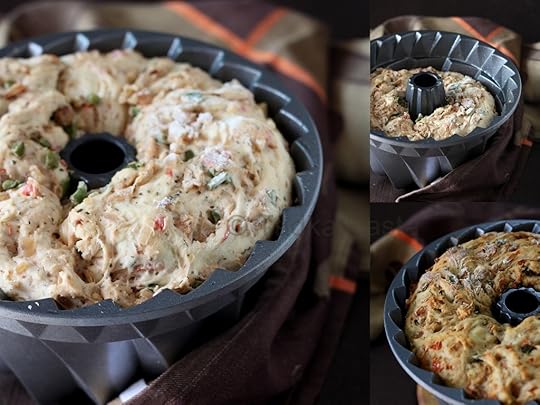 Savoury Kugelhopf with Italian Flavours
Savoury Kugelhopf with Italian Flavours
2 tsp active dry yeast
3/4 cup warm milk
1 tsp sugar
3 cups all-purpose flour
1 tsp salt
75gm salted butter, at room temperature
2 eggs, beaten lightly
2 tsp oil
1/3 cup chopped green bell peppers
1/3 cup deseeded, pulp-free chopped tomatoes
1 cup finely chopped onions
½ cup diced gouda or cheddar cheese
1/3 cup coarsely chopped walnuts, lightly roasted
1 tsp crushed red pepper
1 tsp dried thyme
1 tsp dried basil
½ tsp dried oregano
Soak the yeast in the warm milk along with the sugar for 5 minutes.
To make the dough using a food processor – Put the flour, milk+yeast and salt in the bowl of the processor. Pulse a couple of times to mix. The add the butter, a little at a time, and process till incorporated.
Add the warm milk and process briefly. Now add the eggs and process till mixed. The dough will be soft and sticky. Knead some more, adding more flour, a little at a time and just enough till the dough pulls away from the sides of the bowl. Do not add more flour than necessary. You can also knead by hand or use a stand mixer or bread machine.
Place the dough in an oiled bowl, cover and let it rise until doubled, about an hour.
Meanwhile, heat the oil in a frying pan. Add the onions and fry until golden. Add the chopped green bell pepper and tomato, saute briefly, then remove from heat and set aside.
Grease an 8” kugelhopf mould or bundt pan well or use a large loaf tin. Scatter some of the chopped walnuts in the bottom of the mould. If you’re using a loaf tin or brioche moulds, then press in the walnuts on top of the dough after the second rise, just before baking.
Once the dough has risen, gently punch it down. Then work the cheese, stir-fried vegetables, the remaining walnuts, chillies and herbs into the dough. The best way to do this is to flatten the dough out and spread the flavouring elements all over the surface, fold the dough over and then knead it. The dough will be a fairly sticky, so use a bench scraper to help knead.
Roll the dough into a log and place it in the mould in a circular fashion and pinch the two ends together to close the “circle” of dough. Cover and let the dough rise for about an hour or so, until it reaches the edge/ rim of the mould.
Meanwhile pre-heat oven to 200°C (400°F). Bake the Kugelhopf for about 35 to 40 minutes until the top is golden brown and the inside temperature reaches 80°C (190°F).
Unmould the Kugelhopf onto a cooling rack and let it cool completely before slicing.
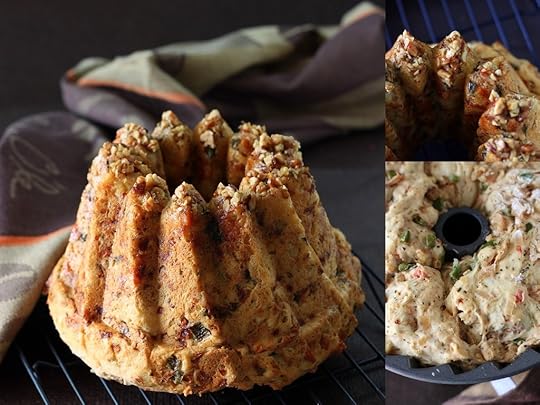 Serve the savoury bread or cake with a cup of soup or a bowl of stew and save the leftovers to toast for breakfast.
Serve the savoury bread or cake with a cup of soup or a bowl of stew and save the leftovers to toast for breakfast.


July 16, 2013
Restaurant Review: Grand Trunk Road Festival at Movenpick
Considering the maddening traffic situation in Bangalore and the fact that we live at quite the opposite end of town, we didn’t think that we’d be heading back to Movenpick so soon. It had just been a week since we were bowled over by the authentic thin-crust pizzas at their Amiamo La Pizza! Festival. This time though the scheme of things was completely different – a gargantuan buffet with the promise of taking us on a food trip down the GT Road. GT Road, as in the Grand Trunk Road? We asked skeptically. The very same, we were told – the road that easily covers 2500 kms and passes through three countries and seven diverse states in the Indian sub-continent.
Well, there’s no doubt about it, the Grand Trunk Road Culinary Trail packs quite a palatable punch. It is long, varied and winding, like the road itself, with pit-stops at a fair number of prominent food hubs along the way. The sheer number of hand-picked dishes is amazing and includes well-known and celebrated favourites, popular crowd-pleasers as well as a few homespun gems to round it all off. There are little touches all around that work as great dinner conversation starters and attest to the restaurant team’s efforts to lift this feast out of the ordinary – the spiffed-up bullock cart parked at the hotel entrance, the old-fashioned lamps, the clay angeethis or stoves topped with rotund earthen serving pots and lids. Executive Chef Thomas Joseph has even commissioned some expert home chefs to don the chef’s uniform and bring their specialty regional dishes to the tables.
So..we sat down to dinner at the Chef’s table with the clatter and aromas of finishing touches being added to the buffet all around us. To start with, the cocktail menu had been transformed to fit into the theme and there was a choice of an Imli Mojito, Sharabi Nariyal, Kala Khatta Daiquiri and Piru Piyala, a guava-based drink. The desi twist on the cocktails was much appreciated and a thumbs up given to all except the Sharabi Nariyal.
At this point hunger pangs had us heading to the colourful chaat counter manned by two friendly ladies who were dishing out Delhi-style Gol-Gappas and Bhalla-Papdi Chaat with great aplomb. The salad menu too had a few themed dishes added to it – a sev-lavished Aloo chaat, Roast beef slices with kasundi or Bengali mustard, and a Chicken tikka with green chutney.
We had been looking forward to the kababs and they did not disappoint. The Pakistani Ghuta kebab – deep-fried pasty ground meat patties were bite-sized with well-rounded flavours and the Macchi ka kebab were succulent and well-spiced. For the vegetarians the Anjeer-mawe ke kebab was quite rich and on the sweeter side and there was a corn-shaped bhutte ke kebab that had nice flavours but had turned a little soft.
We’re always crazy about chutneys and found that many of our fellow diners were too. The tangy Tomato chutney and the spicy Lal mirch-adrak chutney were both interesting and went well with the khasta keema samosas. We also tried a Lucknowi version of Haleem, which was deliciously porridge-y and not greasy at all. Baigun bhajas from Bengal, thick slices of eggplant dipped in batter were being freshly fried-up. With so many delicious options around we found ourselves sampling a little of everything and were quite full even before we hit the main course line-up.
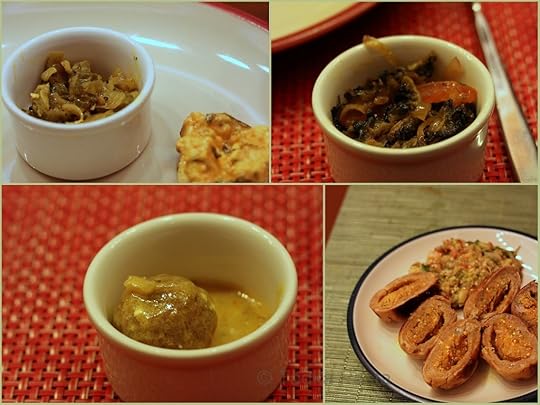 From the vegetarian main dishes that we tasted the highlight was the fabulous paneer which was mild and creamy and just melted in the mouth. The Orai ki torai and the karela subzi were typical dry veggies that would be at home in tons of lunch dabbas across Northern India. Neither the Nafasat ke kofte nor the gravy that are in the picture above were particularly impressive. We did like the earthy Litti-chokha dish that was cooked specially for us by the chef from Bihar.
From the vegetarian main dishes that we tasted the highlight was the fabulous paneer which was mild and creamy and just melted in the mouth. The Orai ki torai and the karela subzi were typical dry veggies that would be at home in tons of lunch dabbas across Northern India. Neither the Nafasat ke kofte nor the gravy that are in the picture above were particularly impressive. We did like the earthy Litti-chokha dish that was cooked specially for us by the chef from Bihar.
 The non-vegetarian curries had us reaching into each pot for just a little taste. Each was unique and we liked the Chooza Khaas Makhani, an interpretation of the ubiquitous Butter chicken, that nevertheless had a nice blend of spices that had everyone trying to guess the right ones. We also enjoyed the Mutton do pyaza and Pakistani murgh kari with some of the Gosht dum biriyani. Tandoori rotis, naans, romali rotis and others of their ilk were served hot and fresh at the table, just the way they should be.
The non-vegetarian curries had us reaching into each pot for just a little taste. Each was unique and we liked the Chooza Khaas Makhani, an interpretation of the ubiquitous Butter chicken, that nevertheless had a nice blend of spices that had everyone trying to guess the right ones. We also enjoyed the Mutton do pyaza and Pakistani murgh kari with some of the Gosht dum biriyani. Tandoori rotis, naans, romali rotis and others of their ilk were served hot and fresh at the table, just the way they should be.
 The dessert counter was a fair riot of colours. Fruit skewered on bamboo sticks, a pot of sticky-sweet Khubani ka Meetha, single-servings of Phirni, plump Gulab Jamuns and more. The small, square pieces of the Bengali Sondesh were the perfect lightly sweet ending but we could not resist a bite of the other desserts too. The carrot halwa disappointed with its consistency and the gulab jamuns were a mite doughy at the centre, but the Phirni and rossogullas ensured a really sweet finish.
The dessert counter was a fair riot of colours. Fruit skewered on bamboo sticks, a pot of sticky-sweet Khubani ka Meetha, single-servings of Phirni, plump Gulab Jamuns and more. The small, square pieces of the Bengali Sondesh were the perfect lightly sweet ending but we could not resist a bite of the other desserts too. The carrot halwa disappointed with its consistency and the gulab jamuns were a mite doughy at the centre, but the Phirni and rossogullas ensured a really sweet finish.
Overall it was a fantastic meal. Apart from the tasty food we enjoyed the way the buffet had been put together. We spent nearly three and a half hours savouring this massive spread and we suggest that you take your time too and pace yourself so that you can enjoy this culinary journey through Grand Trunk road, beautifully and conveniently packaged at Movenpick.
Address: MyPlace, Movenpick Hotel and & Spa, 115 Pipeline Road, Near BEL Circle , Bangalore
Availability: Only for dinner until 21st July and culminates with Sunday brunch on 21st July.
Cost: Rs. 1200 per head, not including taxes and drinks
Phone: 4300 1000
Accepts Cards: Yes
Parking: Valet


July 15, 2013
Restaurant Review: Times Gourmet Week – Rim Naam
When we saw the invite to Times City’s Gourmet Week in our inbox, we hastened to check the list of restaurants and within seconds, had narrowed down the choices to a couple, Rim Naam at The Oberoi being one of them. Having been deprived of Thai food after the long spell of hankering as it were, here in Bangalore, it only seemed logical. We traipsed in there this afternoon and this gorgeous decor had us smitten right at the outset.
The Gourmet Week prix fixe menu at Rim Naam includes an appetizer, main course and dessert for Rs. 1000/- per head for lunch. For dinner there is also a choice of Vegetable or Chicken Tom Yum soup added on, for 1200/- per head. The promotion is on until Sunday, 21st July and reservations at participating restaurants can be made here by paying Rs. 100. Drinks and taxes are not included in the price mentioned.
We started off with Potato Samrose from the vegetarian appetiser options. Deep fried wedges of the spud tossed in a sweetish chili sauce and topped with peanut powder. While there’s hardly anything to nitpick about deep fried potatoes, really, we felt that this dish was a misfit of sorts on an otherwise gleaming Thai menu.
Next were the chicken satays, soft and succulent strips of chicken breast marinated in a mild sauce with hints of lemongrass and Thai spices, and grilled to the right consistency. A rather bland and oily peanut sauce was offered up as a condiment with which to relish these, but we preferred a dollop of the chili sauce on the table. To wash these appetisers down, we chose a lovely Sula harvested Chenin Blanc with heady notes of the season’s finest mangoes.
The aggressive flavours of the colourful Tom Yum soup that came next were marred by a slew of fibrous slivers of kafir lime leaves and lemongrass. We loved the broth, though, with its typical Thai aroma and the warmth of galangal seeping through.
The main course was a montage of some of our favorite things, but the first set to manifest on the table seemed a trifle dull in both taste and looks to our discerning senses. When the chef himself appeared at the table and assured us that he’d replace them with the best dishes from his kitchen, we knew he meant serious business. And thus came the Vegetable Pad Thai, which was just right in spice and sweetness, with a heap of peanut powder and a slice of lemon on the side, not to mention the crisp sprouts. The Tofu Krapao was lip-smacking delicious. Cubes of silky tofu deep fried and sautéed in an impressive Thai sauce, with red hot peppers and red capsicum and Krapao leaves, a basil variety bestowed with a kick of heat.
We were served the most refreshing orange-almond-mocktails and the Pad Thai had to be admired and chronicled twice in order to do justice to how tender the noodles were and how flavorful it was in sum. The Chicken Red Curry hit all the right spots with its spice and coconutty, lemongrassy punches. The little mounds of fluffy white Jasmine rice were gone in a trice, relished with the delicious gravy.
Dessert was simple, a no-brainer: lemongrass and coconut sorbets. While the lemongrass sorbet didn’t appeal too much – we felt that the fresh, lemongrassy flavor we were expecting was missing – the coconut one tasted like it was right out of the thick, creamy can of coconut milk we were all too used to when in the US. The reason for not using fresh coconut milk, we found out after a discussion with the manager, was simply the unavailability of good coconuts all year through.
With lovely decor and great ambience, the sounds of birds chirping within earshot and the flare of green all around and above as in the canopies, and overall good food that turned out to be a little too filling, we’d go back to Rim Naam if we wanted to savor some select dishes that stood out for us with respect to authentic Thai quotient.
Address – Rim Naam, The Oberoi, MG Road, Bangalore
Promotion – Times Gourmet Week
For queries call Times City at 080-41566337 / 41
Accepts cards: Yes
Parking: Valet


July 13, 2013
Phir Na Maango – Mango Phirni!
We couldn’t possibly let the season’s last lot of ultra sweet mangoes go without whisking up a fitting goodbye treat. Thick and creamy, this recipe for Phirni handed down through generations has in all possibility been tweaked scores of times to suit different tastes and incorporate, as in this case, a seasonal fruit to only enhance its richness. In the custardy depths of this sweet Mango Phirni, not only are memories hidden, but the smiles that manifest in the here and now that we won’t forget, ever.
Mango Phirni
(Serves 4)
½ Litre full-cream milk
3 Tbsp rice, washed and soaked for 30 minutes
10 Almonds, soaked and skinned
¼ Cup grated khoya (Milk solids or substitute whole milk powder)
¼ Tsp cardamom powder
½ Cup sugar or to taste
Pinch of saffron soaked in warm milk
1 Small ripe mango, skinned, pitted and pureed
1 mango, skinned, pitted and cut into half-moons for topping
2 Tbsp chopped pistachios
Bring the milk to boil in a heavy-bottomed pan and simmer for about 10 minutes, stirring often.
Grind the rice and almonds separately to a coarse consistency. Do not make it a paste. You should be able to see lots of tiny bits of rice or almonds. This is necessary in order to have the correct consistency in the phirni.
Add the rice and almonds to the milk and cook, stirring almost constantly, for about 8-10 minutes or until the rice is cooked and the milk thickens.
Stir in the sugar and cardamom. Cook for 2 minutes, stirring constantly. Then take the pan off the heat.
Stir in the saffron and mango puree.
Pour the phirni into unglazed mud bowls or cups, if you have them. These will absorb the excess liquid in the dessert and help the phirni to set nicely.
Cover with plastic wrap and allow to cool. Refrigerate overnight or until set.
Garnish the phirni with mango slices and chopped pistachios.



